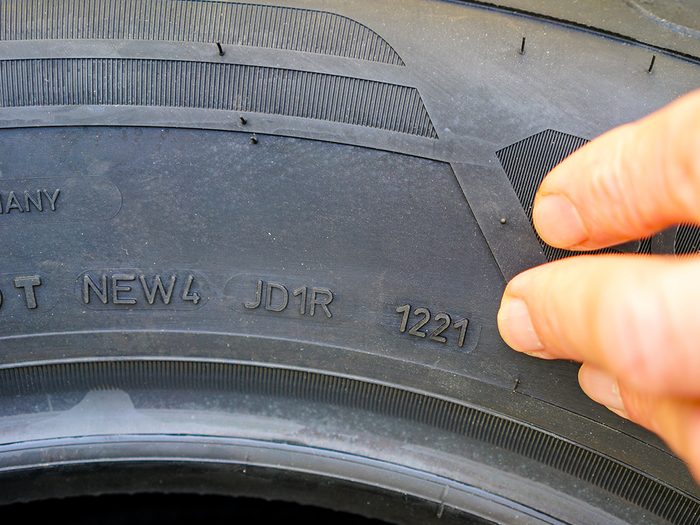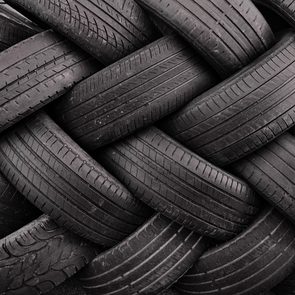This is Why Tires Have Those Little Rubber Hairs on Them

They look funny, yet every new car tire has them.
If you’ve ever looked closely at the tires on your car or touched the tires while wandering around an auto shop, you’ve probably seen those little hairs sticking out of the black rubber and wondered, Why do tires have hairs? Are they there for some safety reason I don’t know about? Those little bits are one of the weird car features most people don’t usually stop to think about. But then some people do.
When it comes to the tire-hair mystery, we asked car experts to solve it for us once and for all. This will free up some mental bandwidth to think about practical tire issues, like why there are numbers and red and yellow dots on tires as well. Here’s what the auto pros told us.
Get Reader’s Digest’s Daily Digest newsletter for more fascinating facts, humour, travel and tech all week long.
What are those little hairs on tires?
Located on the vertical part of the tire, which is also known as the sidewall, these curious little rubber hairs are known as vent spews or—more adorably—tire whiskers. According to Will Robbins, director of consumer product strategy for Bridgestone Americas, these vent spews are a result of the tire manufacturing process and happen as the tread pattern mould is pressed into a new tire. “Each mould is specific to the tire size and type that is being made,” says Robbins. “As the pattern is pressed into the tire’s rubber, the extra or unnecessary rubber requires a way to escape the mold.” Because pinhole-size escape vents are created throughout each mould, little tire hairs are born.
Curiously, there’s no set number of hairs each tire will have. The exact number of vent spews varies based on the design and size of the tires. But the presence of tire hair is universal. They are nothing more than remnants of the intricate process that makes strong and durable tires that safely carry you around town every day.
Why do tires have hairs?
These vent spews are crucial in the tire-making process. During the manufacturing of a tire, a process known as vulcanization occurs. This is when the raw rubber is heated and moulded into the shape of a tire.
Some excess rubber will seep out through small vents or channels in the mold. As the tire cools and the rubber solidifies, these tiny strands, or hairs, remain attached to the surface of the tire. When it comes to what are the hairs on tires for, Margarette Stine, automotive expert at 4WheelOnline, says this: “They help to ensure that there are no trapped gases or air bubbles in the tire that could compromise its structural integrity and performance.”
How do tire hairs affect driving and safety?
They don’t have any effect on safe driving. Because they’re found on the part of the tire rubber that doesn’t hit the road, Stine says they have no impact on how well your tire grips the pavement in rainy weather or the overall comfort of the ride. These rubber hairs also don’t have any impact on road noise; they are merely a testament to the new tire’s arrival in the world.
Should you remove tire hairs?
You can if you want to, but there is no functional reason to do it. If you’re inclined to want to safely trim or remove them for aesthetic reasons, you can do so with extremely sharp scissors or use a fine abrasive tool to shave them off, suggests Stine.
Take caution and use great care to avoid cutting into the actual tire rubber. That can damage the structural integrity of the tire or compromise the tire’s performance, which means, at best, you’ll need to shell out more money to replace a tire. It could also mean you’ll have an accident. But, says Stine, “as long as the process of removing the tire hair is executed with precision, your tire will not be exposed to unnecessary risks.” (Here’s more car tire maintenance advice you’ll wish you’d known sooner.)
What should you do if your tire doesn’t have these rubber hairs?
If you don’t see any of those rubber hairs on your tires, you probably don’t need to sweat it. They are naturally worn away during normal driving, says Robbins, and the presence or absence of these hairs doesn’t really determine if a tire is safe. It’s far more important to regularly examine your tires for signs of wear and tear, such as reduced tread depth, cracks or bulges.
There is one instance, however, where the lack of tire hairs can be a tell: It could be a sign that they are worn, old and need to be replaced. Part of being a responsible car owner means monitoring the health of your tires closely and regularly. Refer to your car manufacturer’s guidelines for when and how often your tires should be replaced.
Next, find out what can happen if you don’t remove your winter tires in the spring.






